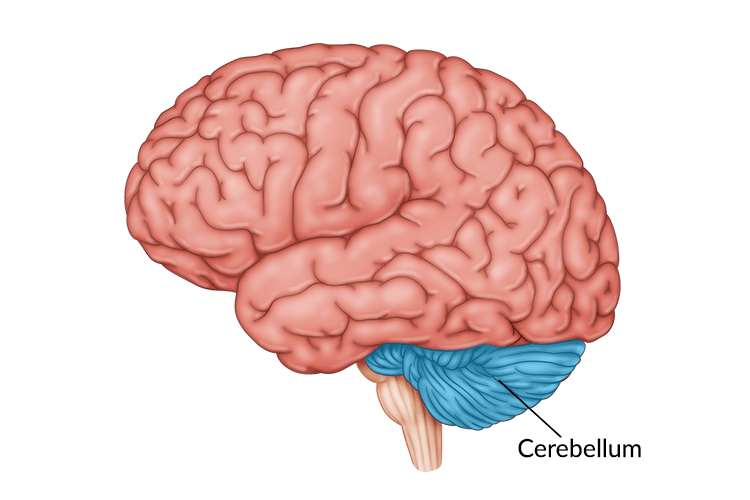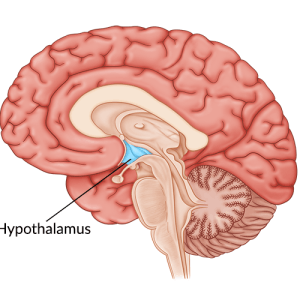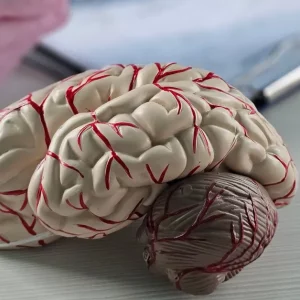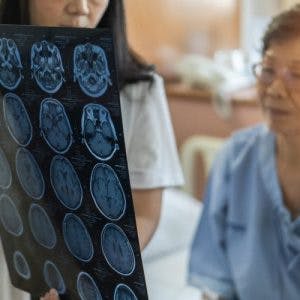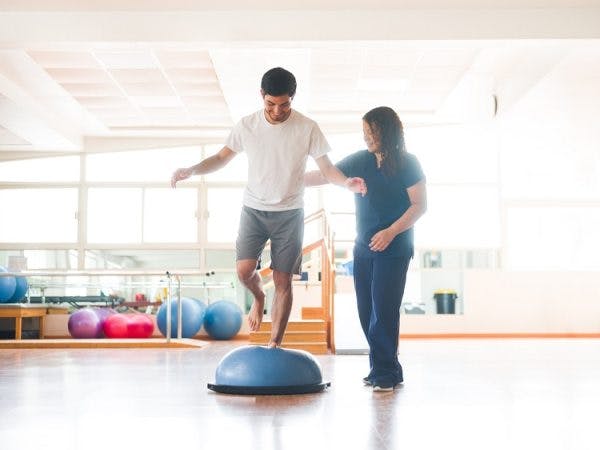Although cerebellum brain damage is relatively rare, its effects can be quite serious. Damage to the cerebellum can result in significant motor, visual, and cognitive changes. However, with the appropriate treatment, individuals may be able to recover affected functions.
In this article, we’ll discuss the effects of cerebellum brain damage and treatment techniques to promote recovery. Use the links below to jump straight to any section:
- What is the cerebellum?
- Causes of cerebellum brain damage
- Secondary effects
- Treatment
- Types of therapy
What is the Cerebellum?
The cerebellum (Latin for “little brain”) is located on the base of the brain, directly behind the brain stem. While it makes up only about 10% of the brain’s mass, the cerebellum contains anywhere from 50% to 80% of the total number of neurons (brain cells) in the brain.
One of the major responsibilities of the cerebellum is to fine-tune and coordinate voluntary movements. This is essential for maintaining balance, muscle tone, and posture. It is also vital in coordinating the movements necessary for walking and other daily activities.
In addition, the cerebellum is crucial to several other functions, including cognition, language learning, eye movement, and reflexes. This means that brain damage to the cerebellum can affect all these functions and many others.
What does the Cerebellum do?
The cerebellum, located at the back of the brain, plays a crucial role in movement, balance, and coordination. Often referred to as the “little brain,” this structure helps fine-tune motor control, ensuring smooth and precise movements.
Functions of the Cerebellum
- Motor Coordination – Integrates sensory input and motor commands to refine movements, making actions like walking, grasping, and speaking more fluid.
- Balance and Posture – Maintain equilibrium and posture by processing information from the inner ear and muscles.
- Muscle Tone Regulation – By continuously adjusting muscle activity, the cerebellum ensures appropriate tension and responsiveness.
- Motor Learning – It plays a vital role in learning new physical skills, such as riding a bike or playing an instrument, through practice and repetition.
- Cognitive Functions – While primarily linked to movement, research suggests the cerebellum also supports language processing, problem-solving, and emotional regulation.
Causes of Cerebellum Brain Damage
Because of the cerebellum’s location, it is fairly protected from external forces. Cerebellum brain damage often occurs due to anoxic brain injury, neurodegenerative disorders, or infection. Alcohol abuse can also cause the cerebellum to deteriorate.
When the cerebellum sustains damage, the signals it sends throughout the body become weaker or can cease entirely. This disruption is what leads to the various secondary effects associated with cerebellar damage.
Secondary Effects of Cerebellum Brain Damage
An injury to the cerebellum can lead to a wide range of symptoms. The following are some of the most common cerebellum brain damage secondary effects:
1. Apraxia: Loss of Muscle Coordination

In order to fine-tune movements, the cerebellum sends inhibitory or excitatory signals to various muscle groups. However, when the cerebellum is damaged, the timing of the messages sent from the cerebellum to the muscles is affected. This results in a lack of coordination known as apraxia.
For example, to pick up a fork, the brain must tell the triceps to activate in order to extend your arm. Your bicep muscle cannot fire while this is happening. Otherwise, your elbow would bend at the wrong time and you’d potentially miss the fork. Therefore, the cerebellum sends inhibitory signals to your bicep while allowing your triceps to easily extend your arm.
Apraxia can affect any movement that requires coordination, making many daily activities much more difficult. Many individuals with apraxia walk with a wide, staggering gait and require extra time to complete simple movements.
Apraxia can also affect your facial muscles and even your tongue, which can cause problems with slurred speech and swallowing.
2. Changes in Motor Function
Other motor effects that may result from cerebellum brain damage include:
- Dysmetria: over- or undershooting the strength, distance or speed needed for tasks
- Dysdiadochokinesia: difficulty performing rapidly alternating movements
- Intention tremors: shaking when performing purposeful movements
- Delayed movement initiation: making a movement slower than intended
- Hypotonia: low muscle tone
The wide variety of motor challenges that can occur after cerebellum brain damage illustrates the depth of the cerebellum’s involvement in many complex motor functions.
3. Balance Problems

Since balance depends on the continuous coordination of several muscle groups, cerebellar damage can lead to severe balance issues. This can affect your ability to walk, climb stairs, or change positions.
You might have trouble holding yourself upright when sitting or standing or feel a strong sense of dizziness. Balance exercises for brain injury and vestibular therapy are excellent ways to address balance problems.
4. Eye Movement Problems (Nystagmus)
Not only does the cerebellum plays a role in coordinating and perfecting muscle movements of the body, but it’s also responsible for controlling eye movements. Following cerebellum brain damage, the eye may make rapid, uncontrolled movements, a condition known as nystagmus.
There are three main types of eye movement a person with nystagmus can experience after cerebellum injury:
- Horizontal nystagmus which involves side-to-side eye movements.
- Vertical nystagmus which causes up and down movements.
- Rotary nystagmus which involves circular eye movements.
These movements can occur in one or both eyes and may cause your field of vision to appear scattered. Nystagmus can also cause severe dizziness after head injury.
Of note, the cerebellum also helps to regulate other visual functions, such as the vestibulo-ocular reflex (VOR). The VOR is what allows you to continue seeing a stable picture even when while you are moving around. These visual functions may also be affected by cerebellum brain damage.
5. Speech Changes
The cerebellum is involved with the coordination of the muscles involved in speech articulation as well as some the cognitive components of language.
One common speech disorder associated with cerebellum brain damage is ataxic dysarthria. Ataxic refers to a lack of motor control, while dysarthria refers to difficulties coordinating the muscles involved in speaking. This may result in scanning speech, which may be slow, slurred, and/or disjointed.
6. Cognitive Effects
Although traditionally cerebellum brain damage was thought to only affect motor functions, research has shown that it can also impact a person’s cognitive functions.
Some of the areas that cerebellum brain damage affects include:
- Ability to organize, plan, and initiate actions (also called executive dysfunction)
- Abstract reasoning
- Working memory
- Visual memory
- Language skills
- Motor learning
Using a combination of speech therapy activities and cognitive rehab exercises can improve your cognitive functions.
Treating the Effects of Cerebellar Damage
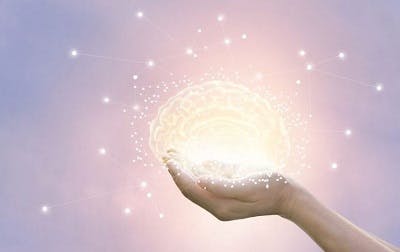
When cerebellum brain damage occurs, the signals that the cerebellum is responsible for transmitting are disrupted. Since the cerebellum plays such as large role in motor coordination, this most often means that muscles are not receiving the signals needed to coordinate movements.
Therefore, individuals must improve the communication between their brain and the rest of the body to recover affected functions. This is possible by completing repetitious exercises to activate the brain’s natural repair mechanism, neuroplasticity.
When you practice a task, even if it is not performed perfectly, your brain forms neural pathways associated with that task. As you continue practicing, these pathways become stronger. Over time, the brain may regain its ability to easily use these new neural pathways to communicate with the muscles, allowing you to coordinate movement again.
Types of Therapy for Cerebellum Brain Injury Recovery
Since cerebellum brain damage can affects each person differently, the treatment required for recovery may vary. However, most individuals following cerebellum brain damage benefit from physical, occupational, and/or speech therapy. The focus of each of these therapies is to activate neuroplasticity to promote recovery.
Physical Therapy
Physical therapists may focus on improving balance and coordination through retraining the brain. They may use strengthening exercises and progressively more challenging activities (such as static standing, standing on uneven surfaces, then walking on uneven ground) to promote functional recovery. Some physical therapists specialize in vestibular therapy, which can help individuals who struggle with dizziness and balance.
Occupational Therapy

Occupational therapists focus on helping individuals complete their daily activities. They may encourage individuals who have apraxia to practice each step of an activity separately before putting them all together. They may also recommend using compensatory strategies and adaptive equipment. Vision therapy is a specialty area of some occupational therapists that may help with nystagmus and other visual concerns.
Speech Therapy
Speech therapists can provide exercises to improve coordination of oral musculature affected by ataxic dysarthria. They can also help with recovering or compensating for lost cognitive functions.
The more you practice affected functions, the more your brain will create new neural pathways to promote improvements.
Understanding Cerebellum Brain Damage
Cerebellar brain damage can cause significant problems with muscle coordination. Fortunately, recovery is possible.
The key to healing any brain injury, including cerebellar injuries, is to engage your brain’s neuroplasticity. Completing therapy exercises daily can promote improvements in your balance, coordination, and cognitive skills. You may even experience a full recovery, depending on how severe your injury was. We hope this guide to cerebellum brain damage gives you the tools you need to make a great recovery.

